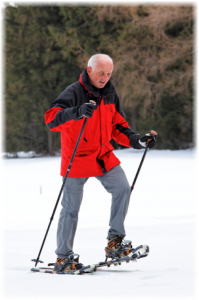 Fit for Life – The Secret to Longevity
Fit for Life – The Secret to Longevity
Freedom Fitness programs support the extensive research confirming the health benefits of exercise, particularly in the senior years.
Statistics Canada, the Public Health Agency of Canada and the World Health Organization are among the leading advocates of a more healthy, active lifestyle.
As people age, chronic conditions can become more prevalent. In fact, for some, functional decline and reduced perceptions of health are to be expected. However, poor health in the senior years is not always inevitable, and modifying certain risk factors may not only prolong life but may also allow seniors to live more years in good health.
The association between being in good health and the frequency of leisure time, physical activity was particularly strong. Among seniors who were active three or more times per week, 67% were in good health. As their activity level declined, however, so did their health.
A decrease in physical activity may also contribute to conditions such as diabetes, arthritis, heart disease and stroke.
– Excerpt from Healthy Living Among Seniors, supplement to Health Reports, Vol. 16. Statistics Canada Catalogue 82-003
In addition to health complications, physical inactivity also makes your body age faster.
Independent living depends on being able to do the things you want to do–when you want to do them. To maintain independence, you need to be able to to reach, bend, lift, carry and move around easily. Therefore, staying physically active is the best way to keep moving and stay strong.
– Excerpt from Physical Activity Guide for Older Adults, Public Health Agency of Canada
Health and functional ability are crucially important to the quality of people’s social lives: level of functional ability determines the extent to which they can cope independently in the community, participate in events, visit other people, make use of the services and facilities provided by organizations and society, and generally enrich their own lives and those of the people closest to them.
 The lowered level of physical activity and the growing number of chronic illnesses that often follow with increasing age, frequently create a vicious circle: illnesses and related disabilities reduce the level of physical activity, which in turn has adverse effects on functional ability and exacerbates the disabilities caused by the illnesses. A greater degree of physical activity can help to prevent many of the negative effects ageing has on functional ability and health. Physical activity is also the best way to break the vicious circle and move on to a path of progressive improvement. This, ultimately, helps elderly people and increases their independence.
The lowered level of physical activity and the growing number of chronic illnesses that often follow with increasing age, frequently create a vicious circle: illnesses and related disabilities reduce the level of physical activity, which in turn has adverse effects on functional ability and exacerbates the disabilities caused by the illnesses. A greater degree of physical activity can help to prevent many of the negative effects ageing has on functional ability and health. Physical activity is also the best way to break the vicious circle and move on to a path of progressive improvement. This, ultimately, helps elderly people and increases their independence.
The research results indicate that as well as increasing muscle capacity, physical activity can help to improve stamina, balance, joint mobility, flexibility, agility, walking speed and overall physical coordination. Physical activity also has favourable effects on metabolism, the regulation of blood pressure, and the prevention of excessive weight gain. Furthermore, there is epidemiological evidence that regular vigorous exercise is related to a decreased risk of cardiovascular diseases, osteoporosis, diabetes and some forms of cancer.
Individuals are always bound to a certain extent by the conditions of their lives and environments. The degree to which they succeed depends largely on functional ability. The better their functional health, the greater their functional freedom within the confines of their life-situations. There is no doubt that physical activity is a crucial factor in maintaining functional health throughout the life span.
– Excerpts from the World Health Organization, Ageing and Health Programme,Growing Older-Staying Well, Ageing and Physical Activity in Everyday Life

